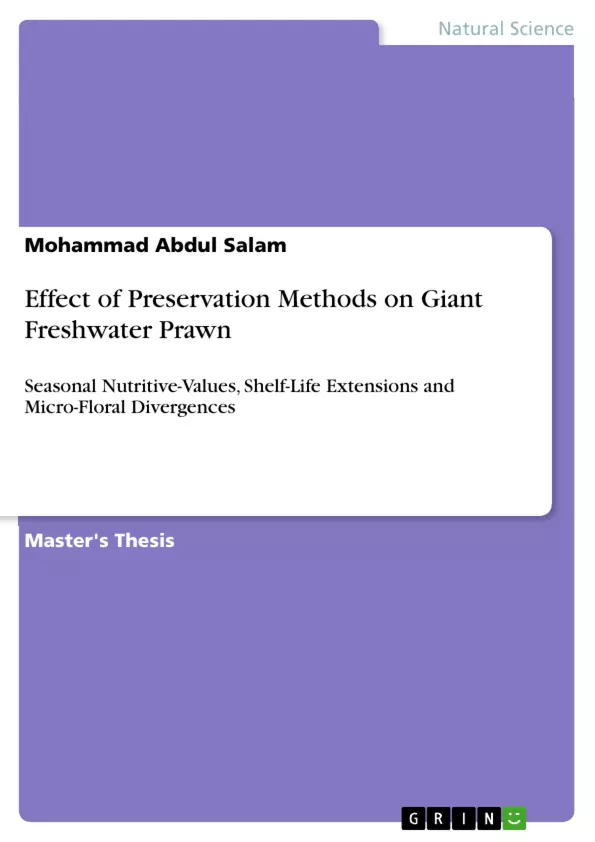To inquest a pertinent technology of preservation seasonal (summer, autumn, winter) nutritive values, effects of potassium sorbate, gamma radiation and their combinations preserved at low temperature on sensory, chemical and microbial properties of freshwater prawn (Macrobrachium rosenbergii, de Man-1879) as well as isolation and identification of associated micro-flora with their sensitivity to potassium sorbate and gamma radiation were investigated during February 2003 to April 2004. Nutritive analysis marked seasonal and body-part variations in moisture, protein, lipid, ash, calcium and phosphorus contents i.e., summer, autumn and winter as 80.07%, 80.37%, 76.99%; 19.20%, 18.03%, 21.30%; 1.23%, 1.07%, 2.99%; 1.48%, 2.00%, 1.21%; 0.19%, 0.21%, 0.14% and 0.10%, 0.08% & 0.10% in edible-part while 77.27%, 76.27%, 73.34%; 16.45%, 17.03%, 19.79%; 1.40%, 1.02%, 4.33%; 6.60%, 7.33%, 6.25%; 2.24%, 2.78%, 1.67% and 0.17%, 0.15% & 0.21% in head-on respectively.
Quality appraisal of treated (potassium sorbate-2%, gamma radiation-2kGy and their combination) and preserved (00C and 40C) samples were done by organoleptic, chemical and microbial evaluation at an interval of 7 days. The shelf life of freshwater prawn at 40C was 14-21 days which was extended to 21-28 days at 00C. Maximum shelf-life (28 days) was found in combined treated prawn that was stored at 00C.
Associated micro-flora were isolated and identified based on their cultural, microscopic, biochemical & physiological characteristics. Among 30 bacterial strains – thirteen (40.33%) were collected from control, nine (30%) from chemical treated, five (16.67%) from radiation treated and three (10%) from combined treated samples. Total 9 bacterial species were identified in which Staphylococcus aureus (23.33%), Bacillus subtilis (20.33%), Micrococcus varians (16.67%) and Escherichia coli (13.33%) were frequent species. Among 10 mould strains – seven (70.00%) were collected from control, three (30.00%) from radiation treated while no colonies were found from chemical and combined treated samples. Total 4 genus of moulds were identified in which Aspergillus (40.00%) was dominant. Potassium sorbate (0, 1, 2, 3, 4 & 5 %) and gamma radiation (0, 2, 4, 6, 8 & 10 kGy) were applied for the sensitivity on identified bacterial species. Staphylococcus aureus, Bacillus subtilis, Micrococcus varians & Escherichia coli were completely eliminated at 4, 5, 3 & 4 % potassium sorbate and 6, 8, 4 & 6 kG gamma radiation doses.
Inhaltsverzeichnis (Table of Contents)
- INTRODUCTION
- 1.1 GENERAL INTRODUCTION
Zielsetzung und Themenschwerpunkte (Objectives and Key Themes)
This thesis investigates the effectiveness of different preservation methods on giant freshwater prawn (Macrobrachium rosenbergii). The research focuses on the seasonal variations in nutritive value, the impact of preservation techniques on sensory, chemical, and microbial properties, and the identification and sensitivity of associated microflora.
- Seasonal variations in nutritive value of giant freshwater prawn
- Effects of preservation methods (potassium sorbate, gamma radiation, and their combinations) on prawn quality
- Shelf-life extension of preserved prawn
- Isolation and identification of associated microflora
- Sensitivity of microflora to potassium sorbate and gamma radiation
Zusammenfassung der Kapitel (Chapter Summaries)
- Introduction: This chapter provides a general overview of the importance of fisheries in Bangladesh, highlighting the country's rich freshwater fish diversity and the economic and nutritional significance of the sector. It also discusses the problem of fish spoilage and the need for effective preservation methods.
Schlüsselwörter (Keywords)
The main keywords and focus topics of the text include nutritive values, low temperature, potassium sorbate, gamma radiation, freshwater prawn, Macrobrachium rosenbergii, bacterial flora, and mould flora.
- Quote paper
- Mohammad Abdul Salam (Author), 2004, Effect of Preservation Methods on Giant Freshwater Prawn, Munich, GRIN Verlag, https://www.grin.com/document/285100



